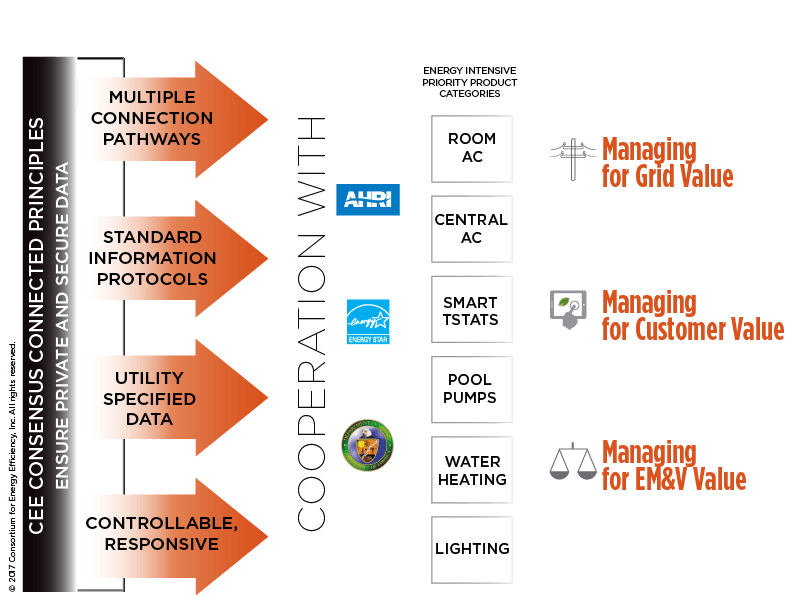
The Consortium envisions a marketplace where both consumers and demand side managers connect to energy consuming devices through multiple pathways and open standards so that connection costs are minimized and choice for consumers and utilities is optimized. Members strives to:
Key components of the CEE connected strategy, illustrated below, are the connected principles for private and secure data, cooperation with relevant partners, selection of product categories, and the desired outcomes for utilities and customers.
Starting in 2012, members could see the high potential for connected devices to benefit customers, the grid, and the environment. Delivering efficiency and demand response at a specific time and place was well within the demand side management mission of CEE. With Consortium experience in developing specifications that meet utility requirements for products, systems, and structures, along with strong relationships with the manufacturers and stakeholders who make these products, CEE is uniquely poised to achieve its vision leading to new energy efficiency, demand response, and storage capability.
Translating Consensus Principles Into an IDSM Platform
Consortium consensus strategy for connected devices

Consortium members recognized early on the necessity of clearly identifying the need for sharing data with manufacturers through secure, standardized, and accessible means. The following principles reflect attributes valued by CEE members and serve as an important precursor to development of actual specifications with associated test procedures, verification procedures, and qualified products lists.
The flip side of an intermittent supply side is a controllable, responsive demand side. But the Consortium vision for connected devices and structures goes beyond this aspect. By anticipating the wealth of knowledge possible with new data streams, IDSM program administrators can, at minimum, improve programs and marketing, cut EM&V costs with more immediate results, understand their own operations in more detail, and improve reliability.
Connectivity may enhance product ability to contribute to a smarter grid and offset or postpone the need for new supply-side resources. While historically load followed demand, new technological advances have created the ability for demand to follow load. A connected product with a dispatchable load that can predictably shed or absorb capacity could intelligently avoid peak periods, respond to authorized demand response signals, or smooth out the impact of intermittent renewable generation resources.
Connected products can provide program administrators with more granular and timely data to measure the impact of their energy efficiency and demand response programs. Members are particularly interested in leveraging connected products to assess the persistence of savings in behavior change programs; however, many widget-based programs could benefit from infield data collection. Performance data collected on a frequent basis, for example, 15-minute intervals, can also provide important information about energy savings opportunities within the home that further informs program design and offerings.
Connected products that offer predictable energy information via open communication pathways have the potential to support engagement platforms offered by CEE members or their partners. This may include efforts to better understand and serve customer segments through the development of targeted DSM programs.
DSM programs are becoming more integrated in the sense that multiple products are coming together in a shared space and providing different benefits, but also in terms of overall objectives. Connected technology allows further integration of efficiency, load management, and behavioral elements from the perspective of program design and impact claims. CEE is currently looking at opportunities to advance residential energy savings associated with the integrated home, which leverages opportunities beyond individual widgets and end measures. It hinges on communicating capabilities to create new levels of data, learning, comfort, and control.
CEE is identifying the connected functionality and information that may help members achieve their demand side goals and increase customer satisfaction. By defining the minimum set of capabilities and data points effective across service territories, portfolios will be better positioned to meet the evolving needs of both programs and customers.
Through new energy efficiency and demand response opportunities, connected products can provide actionable information that compels energy saving behaviors and empowers customers to manage their energy use, including the ability to adapt consumption in response to higher energy prices.
CEE members continue to ramp up efforts to satisfy their customers. Better data and insights can help program administrators customize and endorse the right connected products for individual customers.
CEE members have the opportunity to better serve their customers by identifying connected products that provide new amenity in a consistent, credible manner. Carefully screened connected products can provide remote control, enhanced comfort and convenience, timely diagnostic information, data security, and enhanced customer engagement.